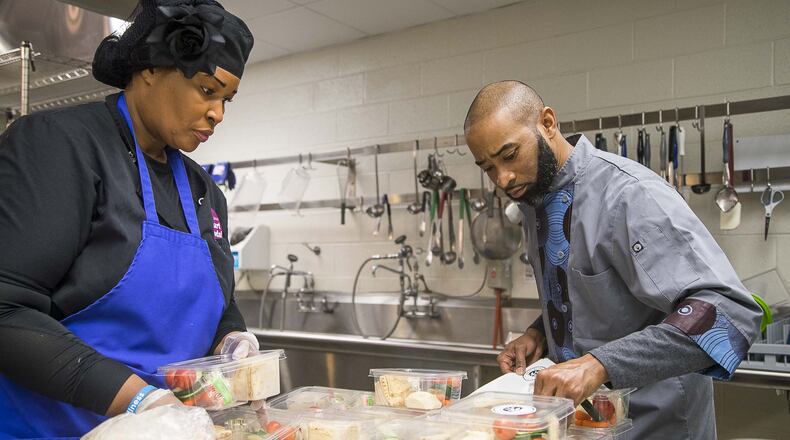Newly proposed changes by the federal government for school lunches received mixed reactions from nutritionists and children’s health advocates across the country.
The rules for the Food and Nutrition Service would allow schools to reduce the serving size of some food subgroups to make them consistent.
From a cost standpoint, school officials say anything that will reduce food waste is a good thing, especially for taxpayers.
However, students need healthy options say state and metro Atlanta nutrition experts. They worry that by allowing school districts laxity, children will pick the least-healthy choice every day.
Those officials say no matter how the Department of Agriculture regulations may change, they’ve found ways to make healthy foods appetizing for students and will continue to offer the most nutritious meals possible.
Related story:Gwinnett offers new lunch options for students
Related story:Shift aims to make school lunch better for students, local farmers
Related story:Georgia schools find meals good for students that kids actually eat
Linette Dodson, school nutrition director for the Georgia Department of Education, said headlines declaring “school lunches will now consist of junk food” confuse the issue for parents and students.
“This isn’t the final rule,” Dodson said. “There’s a 60-day window for public comment and there could be some modifications during that time.”
Dodson said the state supports the flexibility in the proposed plan, but will maintain the quality standards that have been in place across Georgia for years.
“We have programs such as Farm to School and Georgia Grown that improve the nutritional value of student meals and help the local economy,” she said. “Those programs have proven successful and sustainable.”
Fulton County Public Schools has been involved in the Farm to School program since 2011, said Ruth Taylor, the district’s School Nutrition Program coordinator. “We achieved platinum status in the Georgia Organics’ Golden Radish award in 2017 and have maintained it since.”
That designation means Fulton County schools fulfilled 10 criteria involving locally-sourced foods and education practices:
- Offer locally grown items on the school menu,
- Offer student taste tests that feature locally grown food,
- Have students interact with farmers through field trips or visits to school,
- Produce Farm to School promotions in schools,
- Integrate farm to school into standards-based curriculum,
- Maintain edible school gardens,
- Have students participate in hands-on cooking and food activities featuring local food with chefs,
- Have parents and/or community members involved in the farm to school program,
- Have school staff participate in farm to school professional development training,
- Have Farm to School language as part of a district-wide policy or procedure.
‘It’s kind of like art’
Adding fresh fruits and vegetables such as strawberries or cucumbers to flavor water is currently not an option for schools. Under the proposal the administrative restrictions would be lifted. And making a meat or meat alternate easily available for breakfast rather than all of the grains that are now required is another easy fix, according to many nutritionists.
“It allows students to choose turkey sausage, cheese, yogurt, eggs or peanut butter as an option for whole grain products,” said Dodson.
But many critics of the proposed guidelines draw the line when it comes to the definitions of fruits and vegetables. They thought that under the proposal, French fries may be considered a vegetable that can substitute for leafy greens and pasta could replace fruits.
But that’s another misconception, according to a USDA spokesperson.
“Potatoes are currently – and would continue to be – considered a vegetable. However, they count toward one of five required vegetable subgroups (the starchy vegetable subgroup)and would not be counted toward the minimum weekly requirement for dark green vegetables,” according to the spokesperson.
“With regard to fruit, the proposed rule only impacts breakfasts served outside the cafeteria, aligning requirements for what students are required to take at breakfast in the classroom with what they must take at breakfast in the cafeteria. For example, currently students can take one banana if they’re eating breakfast in the cafeteria while for breakfast served in the classroom, students must take two bananas. This proposal would fix that so students could take one banana regardless of where they’re eating breakfast and will help combat the 27% of fruit wasted at breakfast.”
The Atlanta Journal-Constitution recently visited Heards Ferry Elementary in Sandy Springs to observe the school lunch program there. District Chef Reggie Sloan walked a reporter through lunch prep. Sloan and Taylor explained the process involved in providing 11 million breakfasts and lunches each year.
Although there were industrial-sized stoves and machines, food was prepared in small batches. As one food service worker dished out individual portions of salad, she took care to ensure the presentation was appetizing.
“It’s kind of like art,” said Taylor. “The food is colorful and arranged in appealing ways so the students want to eat it.”
Even the Szechuan chicken and fried rice that made up one of the day's hot entrees was bursting with color and freshness. The rice is not really fried because fried foods aren't allowed in schools that are part of the USDA school nutrition program.
“We offer two hot entrees and one cold every day,” said Taylor. “And always at least one vegetarian option.”
That day kids had bento boxes with humus and fresh veggies which proved to be a popular item.
As the first wave of students entered the cafeteria, they waved and called hello to Chef Reggie. As the smallest kids at school, the pre-K kids deftly managed trays piled with selections from all food groups.
“District-wide we serve about 50,000 lunches and 25,000 breakfasts,” said Taylor. “We have about 30 minutes in the morning to get everyone fed who’s taking breakfast and anywhere from two to three hours in the afternoon for lunch.”
With such a tight window to make the nutrition programs work, the most welcomed changes may be the ones the public will never see. The proposal changes the timeline of the administrative review (an audit which currently occurs every three years) to every five years.
This change would allow school food service professionals more time to enhance their programs and would allow state agency oversight staff more time for technical assistance to districts still struggling to meet federal standards, said Dodson.
“The most important thing to remember is that these proposals are for minimum standards,” said Dodson. “We’ve found that most school districts are way above those standards and plan to remain there.”
Taylor added that parents are always welcome to see what kids are eating at school.
“We work to maintain nutritional integrity,” said Taylor. “We don’t change the ultimate guidelines. Our job is to feed children the healthiest meals possible to support educational achievement.”
USDA School Lunch Program Guidelines proposal
The USDA published proposed changes to school lunch guidelines on Jan. 23. There is a 60-day public comment period that ends Monday, March 30.
Information: fns.usda.gov
About the Author
Keep Reading
The Latest
Featured




